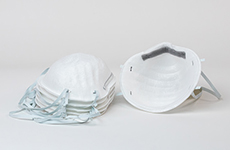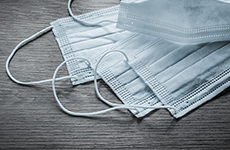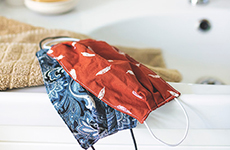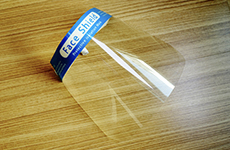The Right Mask for the Task

Related—"Understanding Changing Guidance on Mask Use"
Surgical masks, homemade masks, and respirators have become symbolic of protection during the COVID-19 crisis. How much protection do these masks and respirators really offer, can they be reused, and what are their limits?
In this Q&A, Ana Rule, PhD, and Kirsten Koehler, PhD, offer an introduction to masks, respirators, and their best uses. Rule and Koehler are both faculty in the Department of Environmental Health and Engineering at the Johns Hopkins Bloomberg School of Public Health. They have expertise in aerosol science, bioaerosols, and occupational health.
How do viruses like the novel coronavirus spread?
When we cough, sneeze, and even talk, we all emit droplets—small drops of moisture from the upper respiratory system—of various sizes. These droplets may carry viruses like the one that causes COVID-19.
Large droplets (>5 micrometers) settle quickly. This is why it’s recommended to stay 6 feet from other people. This is also why it’s very important to clean surfaces and wash your hands after touching a surface that could be contaminated.
Small droplets (also called aerosols) emitted from the mouth and nose travel much farther than 6 feet and may stay in the air for an hour or longer, depending on the ventilation in the room. People spending time together in a room may be exposed to these small droplets.
How do masks and respirators protect people from viruses?

N95 respirators are made of special material that removes at least 95% of even the small droplets. They’re also manufactured to fit with a tight seal around the nose and mouth so air and viral particles can’t get around the side of the respirator.
Some N95s (not intended for medical use) have valves in them that vent exhaled breath without any filtration. These vented respirators will not provide protection for nearby individuals in the event that the wearer has COVID-19. These masks are not recommended during the COVID-19 pandemic. If only vented N95 respirators are available, gluing the vent shut will help protect people around you.

Surgical masks are also made of special material, but they don’t provide a seal around the nose and mouth, meaning that smaller droplets may still be inhaled. Surgical masks are good, however, to protect the nose and mouth from larger droplets from coughs or sneezes, and for preventing infected people from spreading droplets.

Homemade cloth masks remove some large droplets but provide little protection against aerosols. They cannot provide a seal around the nose and mouth, and their effectiveness is unlikely to be improved by face shields. If surgical masks are not available, cloth masks worn by infected people may reduce the spread of droplets.

Face shields are plastic barriers worn as eye protection in medical settings. They are intended to protect against splashes and direct coughs or sneezes. They have large openings around the side of the face and provide minimal protection against small droplets. They are more comfortable to wear than cloth masks, but should not be considered a substitute for cloth masks.
Who should use masks?
Health care professionals need access to N95 respirators when caring for patients with infections that can be spread in tiny airborne droplets. They are on the frontlines of the disease and need adequate protection. Sick people do not need to wear respirators.
Surgical masks can be useful to prevent the spread of droplets from infected people. Previous research also shows that surgical masks can be almost as efficient as N95 respirators at reducing influenza infection among health care personnel. This is because they protect the nose and mouth from larger droplets from coughs and sneezes. It is unknown whether this is true for COVID-19.
Cloth masks likely reduce the spread of large droplets from infected people (even those who are asymptomatic), but a recent study found that they do not provide adequate protection for medical staff.
Due to shortages in N95s, many cities and states are now requiring the public to wear cloth masks anytime a person is indoors or cannot maintain 6 feet of separation outdoors. Cloth masks should be washed frequently.
Can N95 respirators be reused?
Yes—and it’s important to note that reused N95 respirators will provide better protection than homemade masks. We can extend the availability of N95 respirator supplies if we reuse them until they are visibly soiled or structurally damaged.
Each mask or respirator should be stored in a separate breathable paper bag at room temperature between uses.
More information on N95 mask reuse can be found here.
When should masks and respirators be discarded?
Discard a mask or N95 respirator when it is contaminated with blood or bodily fluids, when you can no longer obtain a good seal at the nose or around the mouth, or when it is visibly damaged or dirty or hard to breathe through.
This report was updated on August 4, 2020.




